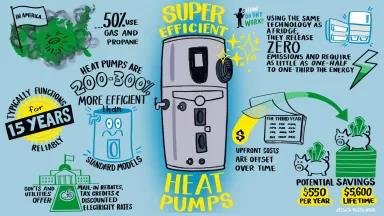How to Lower Your Energy Bills in Any Season
From weather-stripping windows to using the right fan settings, these simple tips can reduce your electricity costs—and keep your family comfortable all year-round.

Zeljko Santrac/iStock
Not only are heating and cooling the biggest sources of carbon emissions in most U.S. homes, but they can also be a huge drain on your wallet. So we rounded up a list of simple ways to lower your energy bills that you can get started on right now. Some of the savings associated with these energy efficiency tips might surprise you. And when you take advantage of state and federal incentives to upgrade some of the appliances in your home that contribute to high energy use, you’ll make the savings go even further—for you and the planet.
Seal up windows, doors, and air leaks
In the colder months, one of the best ways to stay warm and keep your energy bills from skyrocketing is to make sure your home isn’t leaking heat. According to the U.S. Department of Energy (DOE), up to a third of a typical home’s heat loss occurs through windows and doors. Air can also leak into or out of the house through cracks and gaps, such as electrical outlets, baseboards, and attic hatches. Seal around these openings to make your home less drafty and keep warm air inside.
The same advice applies to climate-controlled homes during the warm summers. According to the DOE, caulking leaks can save an average household 10 to 20 percent on annual heating and cooling bills, or up to $166 per year. Weather-stripping your windows can save you an additional 5 to 10 percent annually on heating and cooling bills, or up to $83 per year.
Not all air leaks may be easy to see or access, so once you’ve done what you can, consider bringing in a professional to conduct a full energy audit. It will give you a comprehensive look at all the hidden leaks in your home and provide recommendations on how to seal them to save more energy and money. The Inflation Reduction Act offers a partial tax credit for energy audits, so take advantage of this opportunity to save.
Use window coverings wisely
Closing the curtains during the winter helps reduce up to 10 percent in heat loss from a warm room. (If curtains are hung close to the windows, they can prevent even more heat loss.) However, opening curtains on sunlit windows during the day can help boost temperatures via solar energy. Just remember to close the curtains at night or on windows that don’t get as much sun.
In summer, it’s also a good idea to keep the curtains or blinds closed during the hottest portions of the day. Heat gain through the windows can greatly contribute to the indoor temperature, especially in rooms that get a lot of sun or if your windows are older and less energy efficient.
Adjust the thermostat
Reset your thermostat for times when you’ll be away so that you’re not paying for heating or cooling you don’t use. Then simply adjust the temperature when you return home. In winter, you’ll also spend less if you turn the thermostat down while you sleep. Specifically, lowering the thermostat by 10 to 15 degrees overnight can save approximately 10 percent on your heating bills. A smart thermostat can also be programmed based on when you are usually home or away and what temperature you prefer during those times. The cost of this device can vary from $130 to $200, but it can end up paying for itself, as it can save you around $180 a year in energy costs.
Opt for the fan
A ceiling fan can help a room feel up to 10 degrees cooler and uses just 10 percent of the energy of a central air conditioner, so you save money when you don't have to set your thermostat as low. Make sure your fan is set in the forward (counterclockwise) direction in summer, so that it will pull up the cooler air from the ground and blow it back down onto you, creating a breeze to keep you comfortable. In cold weather, reverse the fan’s direction so that it rotates clockwise, pushing the warm air from the ceiling back down into the room.
Inspect, clean, and replace filters regularly
Basic maintenance of your heating and cooling systems can save you a pretty penny. Ensure filters in your furnace and air conditioners are clean, so the equipment isn’t working harder than it needs to be. Some filters can be cleaned and reused, but others must be replaced entirely, so check your model’s maintenance requirements. Consider calling an HVAC (heating, ventilation, and air-conditioning) professional to evaluate your system for further improvements.
Use devices efficiently
Continuously using technology for work, school, entertainment, and socializing gets costly. Using the energy saver mode on your devices and appliances could easily reduce energy consumption without sacrificing performance. Look for settings called “low power mode,” “battery saver,” or something similar.
Make sure your TV’s standard or normal picture setting is selected and that energy-saving features like automatic brightness control are turned on. Enable “auto power down” on your gaming console to ensure the device goes into low-power mode when not in use. Energy Star estimates that using these power management features could save you up to $30 a year. (For more on Energy Star and EnergyGuide and how your appliances can help you save money, check out our guide.)
Shut down devices you’re not using
Curbing energy waste from devices that may appear to be switched off but are still using electricity (aka “energy vampires”) is another simple way to lower your electric bills. To make it easier to turn off all devices at once, consider an advanced power strip. These reduce electricity waste from idle devices that may still be consuming power in standby mode.
Cook, clean, and wash with less energy
Tweaking how we use some of the most energy-intensive appliances in our homes can go a long way toward lowering utility bills. Here are a few tips:
- Use cold water for laundry and wash full loads to save on energy and water heating.
- Try not to open the oven door to check on your food—the temperature may drop as much as 25 degrees, requiring more energy to heat back up again. You might also try making food in smaller appliances when possible. Slow cookers, pressure cookers, and toaster ovens can sometimes be energy-saving alternatives to your oven.
- Lowering the temperature on your water heater from 140 degrees to 120 degrees can potentially save you up to $400 a year—and you won’t notice the difference.
Choose the right lights
Old incandescent bulbs waste energy and money. When it’s time to buy new bulbs, choose LEDs. The average household has at least 40 light sockets, so your savings will add up quickly. Using LED bulbs throughout your home can save you more than $100 per year.
Invest in green appliances that reduce emissions and shrink energy bills
Considering making bigger investments for your home to lower your utility bills and your carbon footprint? Check out our tips on swapping out costly gas-powered heating and cooling systems and get more ideas in our guide on How to Ditch the Biggest Fossil Fuel Offenders in Your Life.
This NRDC.org story is available for online republication by news media outlets or nonprofits under these conditions: The writer(s) must be credited with a byline; you must note prominently that the story was originally published by NRDC.org and link to the original; the story cannot be edited (beyond simple things such as grammar); you can’t resell the story in any form or grant republishing rights to other outlets; you can’t republish our material wholesale or automatically—you need to select stories individually; you can’t republish the photos or graphics on our site without specific permission; you should drop us a note to let us know when you’ve used one of our stories.




Energy Efficiency: The Clean Facts
What Are “EnergyGuide” and “Energy Star” Anyway?
What Are Heat Pump Air Conditioners?